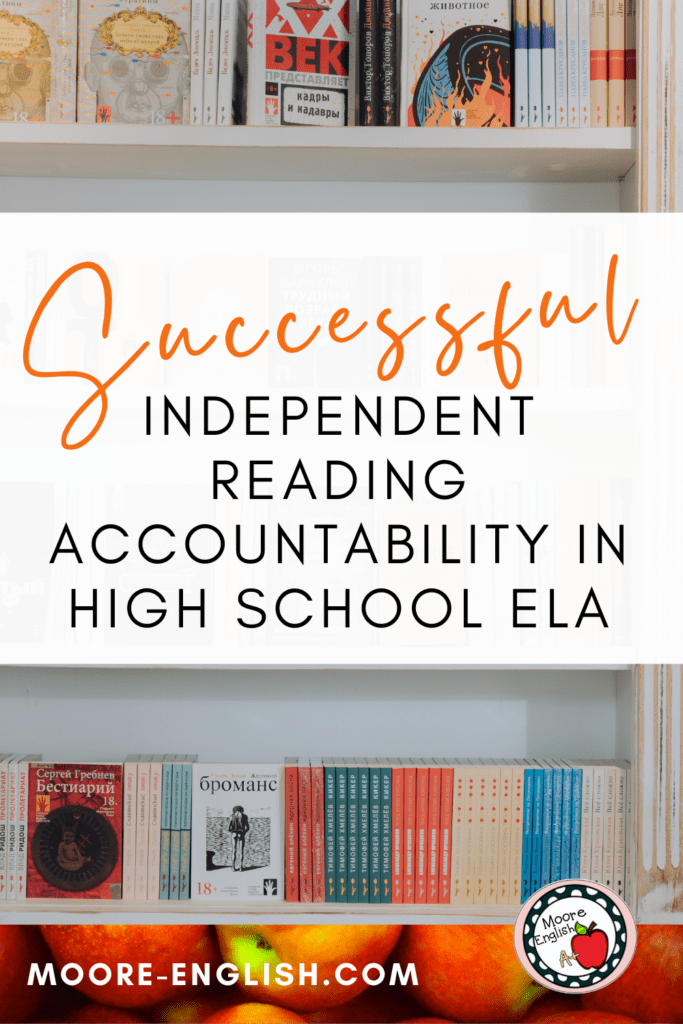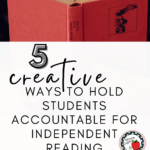On Tuesdays and Thursdays, students start with 10ish minutes of silent reading time. Students choose independent reading books from the library. Each year, my team has a discussion about how to hold students accountable for independent reading. Over the years, I’ve tried lots of different methods for holding students accountable and for limiting the amount of sleeping and fake reading.
This post this post may contain affiliate links. Please read the Terms of Use.
Writing to Respond
My favorite way to hold students accountable for independent reading is through writing!
On the first day of independent reading, students complete a First Impressions Book Review! This helps me identify students that maybe aren’t well matched with their book, but it also gives students a chance to practice opinion writing. After their finish their book review, students use the paper as a book mark. Then, we update our rating and opinion of the book throughout.
Similarly, journals are a great way to hold students accountable for independent reading. (Check out my favorite prompts for choice reading!) I usually choose a prompt that relates to whatever we’re doing in class beyond independent reading. For example, as my juniors were wrapping up their study of rhetoric, their journal asked them to use rhetorical devices to persuade readers to check out their book.
Once students finish writing, they push their journal to the corner of their desk, and I go around to pick them up individually. While I pick up their journals, I chat with students about their writing and ask them questions about their writing and reading. The questions I ask usually come from a place of genuine interest in their reading, so it doesn’t come off as a formative assessment.
As an alternative to traditional journals, students can also write letters to the author of their book and/or to the characters, perhaps even writing from the perspective of a character! Grab my letter writing rubrics today!
Comprehension Interviews
A few years ago, I attended professional development about The Next Step Forward in Guided Reading by Jan Richardson. (Yes, I believe guided reading belongs in high school!)
During this PD session, I was introduced to the concept of a comprehension interview. A comprehension interview is a little more formal than the conversations I have with students after they journal.
For one thing, I keep notes about comprehension interviews and focus them on specific skills (like summarizing, identifying and analyzing tone, identifying theme, etc.). I also do a quick fluency check with each comprehension interview by asking students to read a paragraph aloud.
At the beginning of the year, I do the same comprehension interview with each student. As the year progresses, I adjust which questions I ask and which students I interview. More than anything, this strategy gives me data about which students to invite to intervention.
Self-Designed Independent Reading Quizzes
As an occasional complement to journaling and comprehension interviews, I sometimes ask students to design their own quiz questions for their independent reading books.
- First, I focus in on a specific skill (characterization, point of view, figurative language, etc.).
- Then, I tell students what kind of question they are going to write. Usually, I only ask for one question, but sometimes a two-part question is the better choice. For example, a two part question might be: first, what is the main idea; second, which piece of evidence supports the main idea?
- Next, I model the question type for students using some other content and my own independent reading book.
- Then, I give students a template to fill. Usually, I do this in a collaborative Google Slides where each student has a slide. This gives students a chance to look at examples from their classmates, standardizes the format, and makes it so fast to evaluate!
- Finally, I require students to provide an answer key explaining which answer is correct and why and which answers are incorrect and why.
Pro Tip: Students love a good nonsense answer, so I usually tell them they can have one goofy answer. This is an especially good way to differentiate this lesson.
Independent Reading Task Cards
Task cards are another fun way to hold students accountable for independent reading. When I want to use task cards with independent reading, it’s usually because I want to differentiate prompts for students.
With that in mind, I’ll grab whatever deck of task cards I want to use (it helps that my task cards are super organized!). Then, knowing which students I want to give specific prompts, I will “stack” the deck. For students, it looks like everyone is getting a random card.
How students respond to task cards depends on the day and the rest of our schedule. Sometimes students verbally respond during a quick chat. Other times they write their answers on paper or in response to a Google Classroom post. Most of the time, I use task cards as exit tickets.
In the end, this activity reveals a few things. First, it gives me insight into who is reading their book critically. Secondly, it gives me insight into who is struggling with a specific skill. This lets me know where to place scaffolding in the future, how to group students, and who to invite to intervention.
Independent Reading Stations
Stations are one of my favorite instructional strategies because they incorporate meaningful movement!
When I have an odd day during a unit (perhaps we have an assembly bell schedule) or at the end of a unit (who wants to start a new unit on a Friday?), we can focus on our independent reading books.
During this time, literary analysis stations are the way to go! While I usually do literary analysis stations with a whole class novel, they also work well with independent reading!
Exactly which stations I choose depends on what skills we’re covering in class and how many students I have in class.
Here’s an example station rotation:
- Comprehension Interviews or Guided Reading: Any time we do stations, I am always a station. What happens at my station depends on my students, but this is the perfect time for comprehension interviews or guided reading!
- Plot and Conflict Analysis: A good plot diagram is a great way to help students analyze plot structure, especially if you’re focusing on cause-and-effect. To elevate this activity, students can complete a comic strip for the key plot events.
- Characterization Station: Analyzing characterization is a skill my students can always improve, so this station is a staple for me. To keep it interesting, I have several graphic organizers to choose from. I rotate the graphic organizers so I can do this activity several times throughout the year.
- Theme Graphic Organizer: Connecting evidence to theme is a tough skill, and it’s one students work on all year long. A theme station is a great place for a graphic organizer that helps students visualize the connections between an author’s choices and their message.
- Single-Player Figurative Language BINGO: Since students are all reading different books, full-class BINGO wouldn’t make sense. However, single-player BINGO allows each student to focus on their own independent reading book while still practicing identifying figurative language.
All of these stations printables are available in my Literary Analysis Stations Bundle!
Summative Accountability for Independent Reading
At the end of the day, my favorite way to hold students accountable for independent reading is to take it somewhere. While I see how independent reading helps students develop their vocabularies and reading stamina, students don’t always see that. Similarly, while I appreciate how independent reading allows us to practice skills transfer, that isn’t always meaningful for students.
However, when students can create something with their independent reading, it immediately becomes relevant! While I’m not wild about traditional presentations where students drone to their classmates, some fun alternatives are book talks and book trailers. My favorite version of this activity is Book Cover Design Projects!
How do you hold students accountable for independent reading?














